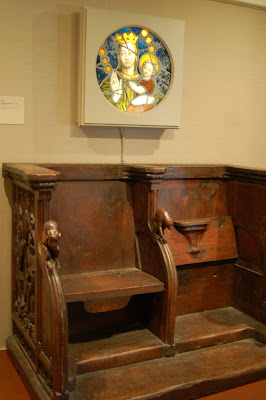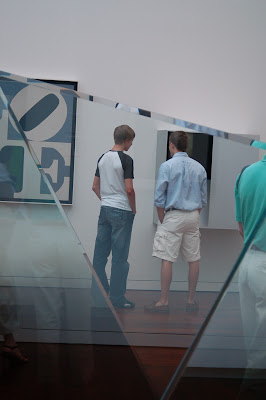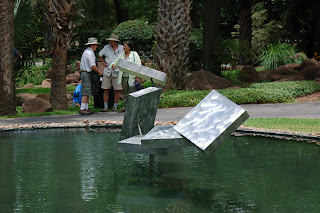Each year, thousands gather at UTSA's Institute of Texan Cultures to participate in the San Antonio Folklife Festival. With over forty different cultures represented, one can easily become immersed in the festivities. Countries such as Chile, the Philippines, Japan, and Germany are represented in the three-day event. With dancers representing nations such as Lebanon and Israel, the Folklife Festival brings together people who would naturally have enmity toward one another. But here, only celebration occurs. Celebration of culture and life, traditions and heritage. The San Antonio Folklife Festival reminds its participants of the uniqueness of every individual and how important that individuality is to the worldwide community.
Whenever the United Nations gathers together in an attempt to provide solutions to global dilemmas, the differences appear to divide them into factions reminiscent of elementary school days when the girls were determined that girls were better than the boys and vice versa. The interesting thing is, as adults, we realize that neither females nor males can survive without one another. Due to biological design, we must coexist in order to perpetuate. In the same way, the members of the United Nations understand that no country can exist without the existence of all the rest. International economics breaks down the Berlin wall of isolationism, and the new focus on global climate has destroyed that wall's very foundation. Of course, nations can inhabit the same planet and become involved with international trade in the same way that an elderly couple stays married though love has long vanished simply because they know not what else to do. However, if nations treat each other in this manner, the path to making history will be long and arduous, unpleasant for the monarchy and torturous for the peasant. Therefore, man must search for the missing link in the UN. What is it that causes tensions to flare and self-interest to overtake negotiations like the tsunami of Sri Lanka?
Despite all the entertainment and joy at the San Antonio Folklife Festival, I could not help but feel a sense of lose. Soon, my friend and I discovered why the festival felt so empty. Not one African culture was represented. Not even Egypt or the more modern cultures were represented in the array of events. Peoples from almost every other continent had gathered to celebrate, but a key member of the world, Africa, which makes up about a fifth of the earth's landmass, was completely absent. I do not know the reason that such a key part of the global community (and the United States' heritage) was not represented, but I do know that these such happenings are at least one of the reasons for the failure of the United Nations. Not to say that the United Nations cannot succeed. But so far as they have attempted to "unite the nations," they have done a pretty pathetic job. I do not feel the need to list the UN's failures at this time. I rest my case by challenging anyone to name five times in which they effectively brought peace to a violent or potentially violent situation.
Therefore, the United Nations has failed to reach its full potential because it continues to leave out key participants in its discussions. Of course, many people already know that the UN does too much "talking" and too little action, but involving all of the players of an international situation creates a much easier task of "doing" when they are all on the same page in the discussion. International cooperation is not a simple task. In fact, I do not believe complete cooperation can ever be achieved due to the selfish and power-hungry nature of so many individuals. Those who are strong must hold up the other members, possibly disciplining or breaking them in order to make them heal even stronger. Yet even more so, when one link is missing, the entire chain is useless. So, we must remember that when we embrace one another's heritage and abilities, not leaving out any member of our world, we can walk down that arduous road knowing that we have one another to lean upon.
Sunday, June 15, 2008
Monday, June 9, 2008
Connecting the Old and the New
This past weekend, I traveled down to the McNay Art Museum in my home city of San Antonio to view the new exhibit that was open to visitors free of charge for two days. Surprisingly, considering my appreciation for art, I had never been to the McNay. For the most part, it contained what I expected, but what I did not foresee was the manner in which the old connected with the new. The McNay is a two part museum connecting an old mansion containing classical and cultural art with a new $50 million center full of modern and post modern painting and sculptures. The division was quite clear but did not feel forced. Somehow, it seemed proper that Auguste Rodin would be in the same facility as Jason Pollock, despite their obvious differences. While I tend to gravitate much more strongly to one than to the other, I understand that I, as the observer, cannot give standards that these artists must follow in order to fulfill my
Museum in my home city of San Antonio to view the new exhibit that was open to visitors free of charge for two days. Surprisingly, considering my appreciation for art, I had never been to the McNay. For the most part, it contained what I expected, but what I did not foresee was the manner in which the old connected with the new. The McNay is a two part museum connecting an old mansion containing classical and cultural art with a new $50 million center full of modern and post modern painting and sculptures. The division was quite clear but did not feel forced. Somehow, it seemed proper that Auguste Rodin would be in the same facility as Jason Pollock, despite their obvious differences. While I tend to gravitate much more strongly to one than to the other, I understand that I, as the observer, cannot give standards that these artists must follow in order to fulfill my likings.
likings.
Life is the same. In life, I am mostly an observer. Yes, I can make decisions, and I believe free will often overrules Fate. Yet at the same time, a human being cannot determine the manner in which his or her life changes over time. As I prepare for college, I realize that I cannot choose the day it will begin or end. Although I may wish to turn back the clock on some things, and push it forward toward others, I realize that over this change, I have no control.
So, I see only one option for us "innocent by-standards" who are constantly tossed about by the sea and its winds of change. We must take life with a grain of salt. When I stood in a room filled with art that I found extremely difficult to appreciate, I found one piece that I enjoyed and focused on it. I noticed the other works, but I cannot tell you their details. On the other hand, that one painting that I found to be a complete masterpiece, I studied. I analyzed the artist's thought process and what the colors and shades could possibly represent. I relished in its beauty and in the skill of the artist's brush strokes. All this time, the other works of art attempted to distract me. To my right, a painting of squirrels invading a cottage; to my left a portrait of a man where the paint is bleeding down the canvas. Still, I stand and stare at the masterpiece in front of me. A ocean view of a horizon with a glare from the sun gleaming yellow, orange and blue in the layers of a sunset on the deep blue sea. A gold pocket watch hangs in the center of the painting, attached to a cord. This painting makes me realize once again that time is always an object. Time, even in the most peaceful of places, marches on. So savor it. Find that one piece of art in the midst of hundreds that captures your attention and don't take your eyes off of it. Though others distract you all around, do not be disturbed by their complex messages. Take the samples of life that you enjoy, and enjoy every minute you have with them. As the things of your old life fade and new changes arise, do not forsake either, but connect them in glorious harmony. By learning from the past, you will better understand the future. Learn to connect the old and the new, filling every moment with the things you love most, and you will surely find that your life is a musuem, holding all of the masterpieces of time, from beginning to end in a beautiful panorama of color and beauty.


Life is the same. In life, I am mostly an observer. Yes, I can make decisions, and I believe free will often overrules Fate. Yet at the same time, a human being cannot determine the manner in which his or her life changes over time. As I prepare for college, I realize that I cannot choose the day it will begin or end. Although I may wish to turn back the clock on some things, and push it forward toward others, I realize that over this change, I have no control.
So, I see only one option for us "innocent by-standards" who are constantly tossed about by the sea and its winds of change. We must take life with a grain of salt. When I stood in a room filled with art that I found extremely difficult to appreciate, I found one piece that I enjoyed and focused on it. I noticed the other works, but I cannot tell you their details. On the other hand, that one painting that I found to be a complete masterpiece, I studied. I analyzed the artist's thought process and what the colors and shades could possibly represent. I relished in its beauty and in the skill of the artist's brush strokes. All this time, the other works of art attempted to distract me. To my right, a painting of squirrels invading a cottage; to my left a portrait of a man where the paint is bleeding down the canvas. Still, I stand and stare at the masterpiece in front of me. A ocean view of a horizon with a glare from the sun gleaming yellow, orange and blue in the layers of a sunset on the deep blue sea. A gold pocket watch hangs in the center of the painting, attached to a cord. This painting makes me realize once again that time is always an object. Time, even in the most peaceful of places, marches on. So savor it. Find that one piece of art in the midst of hundreds that captures your attention and don't take your eyes off of it. Though others distract you all around, do not be disturbed by their complex messages. Take the samples of life that you enjoy, and enjoy every minute you have with them. As the things of your old life fade and new changes arise, do not forsake either, but connect them in glorious harmony. By learning from the past, you will better understand the future. Learn to connect the old and the new, filling every moment with the things you love most, and you will surely find that your life is a musuem, holding all of the masterpieces of time, from beginning to end in a beautiful panorama of color and beauty.
Subscribe to:
Posts (Atom)